TcSUH In The News
April 30, 2021
S. Butler, TcSUH Office of Public Affairs
713-743-8212; sbutler@uh.edu
Scholarship Recipients Announced for Fall 2021 – Spring 2022
Houston, TX - The Scholarship Committee for the Texas Center for Superconductivity at the University of Houston (TcSUH) is pleased to announce five TcSUH scholarship recipients for the 2021-2022 academic year. Students will be honored and presented certificates at a reception in the Fall, subject to UH COVID policies.
Scholarship recipients are selected from undergraduate or graduate students in research programs aligned with the Center, with selection based on the student’s academic and research accomplishments. While a high GPA is an essential factor, the committee considers the number of internal and external oral presentations, prizes and awards, number of papers, and other outstanding service or contributions.
C. W. Chu Scholarships
The C. W. Chu Scholarships were established by multiple donors in recognition of the outstanding research of Professor Paul C. W. Chu and are awarded to talented students in the fields of physics, chemistry, or materials science. Two awards are being made for the 2021-2022 academic year, as follows.
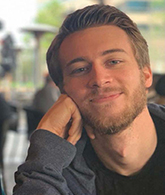 Trevor Bontke began his Ph.D. studies with a focus in condensed matter physics in
Fall 2018 after graduating magna cum laude with Bachelor of Chemistry and
Bachelor of Physics degrees from the University of North Texas, Denton. He
received the University of Houston Presidential Scholarship in 2018 for two years
and joined Professor Paul C. W. Chu’s group in 2019. He is developing and
executing a technique envisioned by Prof. Chu to retain the high-pressure-induced
superconducting phases in high-temperature superconductors without pressure.
Although high pressure has long enabled high Tc, it becomes the most severe
obstacle to the universal application of high-temperature superconductivity. All of the current record-high Tcs
of high-temperature and room-temperature superconductors occur only under ultrahigh pressure, making any
application impractical. Trevor has become particularly skilled in high-pressure techniques and has been
heavily engaged in the successful demonstration of this Tc-retention concept, first in non-superconducting
elemental Bi and currently in the high-temperature superconductor FeSe. Trevor will extend his study to
higher Tc materials and eventually to the hydrides reported to display signs of Tc close to room temperature.
After completing his Ph.D. work, Trevor hopes to remain in academia to investigate novel superconducting
materials while working to discern their origin and that of other important condensed matter phenomena.
Trevor Bontke began his Ph.D. studies with a focus in condensed matter physics in
Fall 2018 after graduating magna cum laude with Bachelor of Chemistry and
Bachelor of Physics degrees from the University of North Texas, Denton. He
received the University of Houston Presidential Scholarship in 2018 for two years
and joined Professor Paul C. W. Chu’s group in 2019. He is developing and
executing a technique envisioned by Prof. Chu to retain the high-pressure-induced
superconducting phases in high-temperature superconductors without pressure.
Although high pressure has long enabled high Tc, it becomes the most severe
obstacle to the universal application of high-temperature superconductivity. All of the current record-high Tcs
of high-temperature and room-temperature superconductors occur only under ultrahigh pressure, making any
application impractical. Trevor has become particularly skilled in high-pressure techniques and has been
heavily engaged in the successful demonstration of this Tc-retention concept, first in non-superconducting
elemental Bi and currently in the high-temperature superconductor FeSe. Trevor will extend his study to
higher Tc materials and eventually to the hydrides reported to display signs of Tc close to room temperature.
After completing his Ph.D. work, Trevor hopes to remain in academia to investigate novel superconducting
materials while working to discern their origin and that of other important condensed matter phenomena.
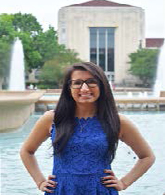 Shruti Hariyani joined the Chemistry department as an undergraduate student and
began her Ph.D. studies in 2018 with Professor Jakoah Brgoch. She is
investigating the local and average structure of oxide and mixed anionic
phosphors. The most common LED-based light bulb available in stores today
utilizes a blue InGaN LED and the yellow-emitting Y3Al5O12:Ce3+ phosphor.
The combination of blue and yellow light appears white to the eye; however,
these lights tend to have a notorious blue tint. Scientists have linked chronic
exposure to the blue-tinted light from these bulbs to mood disorders and cataract
formation. Shruti’s graduate thesis is on the development and advanced characterization of new
phosphors that are compatible with violet LEDs to reduce the amount of blue light and produce a
‘human-centric’ light. In addition, she is focusing on utilizing experiment and computation to
understand the effect of rare-earth substitution on the average and local structure of oxide and mixed
anionic systems. She has 14 published or accepted papers, with four as the first or co-first author in journals
such as Chemical Materials, ACS Applied Materials and Interfaces, and Applied Physics Letters. One
publication received the Chemistry of Materials Lectureship and Best Paper Award by the American
Chemical Society in 2021. She also has a patent pending on a novel blue-emitting fluorophosphate phosphor.
Shruti Hariyani joined the Chemistry department as an undergraduate student and
began her Ph.D. studies in 2018 with Professor Jakoah Brgoch. She is
investigating the local and average structure of oxide and mixed anionic
phosphors. The most common LED-based light bulb available in stores today
utilizes a blue InGaN LED and the yellow-emitting Y3Al5O12:Ce3+ phosphor.
The combination of blue and yellow light appears white to the eye; however,
these lights tend to have a notorious blue tint. Scientists have linked chronic
exposure to the blue-tinted light from these bulbs to mood disorders and cataract
formation. Shruti’s graduate thesis is on the development and advanced characterization of new
phosphors that are compatible with violet LEDs to reduce the amount of blue light and produce a
‘human-centric’ light. In addition, she is focusing on utilizing experiment and computation to
understand the effect of rare-earth substitution on the average and local structure of oxide and mixed
anionic systems. She has 14 published or accepted papers, with four as the first or co-first author in journals
such as Chemical Materials, ACS Applied Materials and Interfaces, and Applied Physics Letters. One
publication received the Chemistry of Materials Lectureship and Best Paper Award by the American
Chemical Society in 2021. She also has a patent pending on a novel blue-emitting fluorophosphate phosphor.
Cora Hawley Scholarships
Mrs. Cora Hawley established scholarships to further the careers of exceptional students aligned with TcSUH research programs from the College of Natural Sciences and Mathematics and the Cullen College of Engineering. Three graduate students were selected for the 2021-2022 academic year.
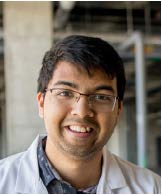 Faheem Ershad joined the Ph.D. program in biomedical engineering in 2018 after
completing a B.S. in biomedical engineering with a minor in nanoengineering. In
recognition of his undergraduate excellence, Faheem received the prestigious NSF
Graduate Research Fellowship. Prof. Cunjiang Yu is his advisor. He has been
investigating drawn-on-skin electronics for motion artifact-less sensing and point-ofcare
treatment in one of his research projects. He has developed stretchable
conductive and semiconducting inks for ballpoint pens and designed sensors directly
on the skin. He also demonstrated an operational drawn-on-skin transistor as proof of
concept. This work was reported or highlighted by >50 scientific and news outlets, such as Science Daily,
Scientific American, Physics World, and EurekAlert. His paper was in the Top 50 Nature Communications
chemistry and materials science articles published in 2020. Faheem also leads important work on the
development of soft rubbery bioelectronics as medical implants for the heart. Rubbery bioelectronics can
harmonically interface with soft human tissues and organs for sensing, diagnosis, prevention, and therapy.
Faheem and co-workers developed a rubbery bioelectronic epicardial patch entirely made of materials with
similar mechanical properties of heart tissue. The patch can provide multimodal sensing, actuation, and
pacing functions while concurrently deforming with a beating heart, as a breakthrough in cardiac pacemakers.
The device is the first-of-its-kind bioelectronics that seamlessly matches the properties of the soft tissues. This
work was published in Nature Electronics and was reported or highlighted by >30 scientific and news outlets
such as Science Daily, The Medical News, Medgadget, ScienMag, and Bioengineer. He has published 13
papers, with two in Nature Electronics, one in Nature Communications, and three in Science Advances.
Faheem Ershad joined the Ph.D. program in biomedical engineering in 2018 after
completing a B.S. in biomedical engineering with a minor in nanoengineering. In
recognition of his undergraduate excellence, Faheem received the prestigious NSF
Graduate Research Fellowship. Prof. Cunjiang Yu is his advisor. He has been
investigating drawn-on-skin electronics for motion artifact-less sensing and point-ofcare
treatment in one of his research projects. He has developed stretchable
conductive and semiconducting inks for ballpoint pens and designed sensors directly
on the skin. He also demonstrated an operational drawn-on-skin transistor as proof of
concept. This work was reported or highlighted by >50 scientific and news outlets, such as Science Daily,
Scientific American, Physics World, and EurekAlert. His paper was in the Top 50 Nature Communications
chemistry and materials science articles published in 2020. Faheem also leads important work on the
development of soft rubbery bioelectronics as medical implants for the heart. Rubbery bioelectronics can
harmonically interface with soft human tissues and organs for sensing, diagnosis, prevention, and therapy.
Faheem and co-workers developed a rubbery bioelectronic epicardial patch entirely made of materials with
similar mechanical properties of heart tissue. The patch can provide multimodal sensing, actuation, and
pacing functions while concurrently deforming with a beating heart, as a breakthrough in cardiac pacemakers.
The device is the first-of-its-kind bioelectronics that seamlessly matches the properties of the soft tissues. This
work was published in Nature Electronics and was reported or highlighted by >30 scientific and news outlets
such as Science Daily, The Medical News, Medgadget, ScienMag, and Bioengineer. He has published 13
papers, with two in Nature Electronics, one in Nature Communications, and three in Science Advances.
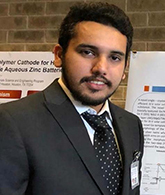 Sahil Sharma, a Ph.D. student in materials engineering, joined Prof. Venkat
Selvamanickam’s group in Fall 2018 after completing his M.S. degree. His project is
on flexible, inexpensive, high-efficiency gallium arsenide solar cells. Fabrication and
testing of flexible gallium arsenide solar cells is a complex process that requires
utmost care to ensure high-quality devices. Sahil learned and implemented the device
fabrication process in a short time to demonstrate high-efficiency devices. He
developed a microlens technique to achieve simple microconcentrators to increase
ten-fold the power output of the flexible GaAs solar cells. He collaborated with Prof.
Shih’s group in Electrical Engineering at the University of Houston to customize custom microlenses with the
GaAs microcells, which was challenging. Flexible gallium arsenide solar cells with 10x the power output
using microlens microconcentrator arrays can be utilized as roof-top solar cells to extend the driving range of
electric cars. Sahil then developed an innovative method for exfoliation of gallium arsenide solar cells that
enables re-use of the wafer substrate, which is the most expensive solar cell component. His method is based
on a water soluble buffer layer which enables easy exfoliation, leaving behind a pristine wafer surface that
does not require chemical mechanical polishing for re-use. UH filed a patent application, and the U.S.
Department of Energy Solar Technologies Office (SETO) funded a proposal to fully demonstrate this method.
Top researchers in the gallium arsenide solar cell field, including those from National Renewable Energy
Laboratory (NREL) and a leading industry, expressed great interest in Sahil’s new technology. He is a coinventor
on two patents in progress, “Compound Semiconductor Devices with Epitaxial Lift-off Architecture”
and “Microstructuring GaAs Substrate Using Reverse-Patterning Lithography.”
Sahil Sharma, a Ph.D. student in materials engineering, joined Prof. Venkat
Selvamanickam’s group in Fall 2018 after completing his M.S. degree. His project is
on flexible, inexpensive, high-efficiency gallium arsenide solar cells. Fabrication and
testing of flexible gallium arsenide solar cells is a complex process that requires
utmost care to ensure high-quality devices. Sahil learned and implemented the device
fabrication process in a short time to demonstrate high-efficiency devices. He
developed a microlens technique to achieve simple microconcentrators to increase
ten-fold the power output of the flexible GaAs solar cells. He collaborated with Prof.
Shih’s group in Electrical Engineering at the University of Houston to customize custom microlenses with the
GaAs microcells, which was challenging. Flexible gallium arsenide solar cells with 10x the power output
using microlens microconcentrator arrays can be utilized as roof-top solar cells to extend the driving range of
electric cars. Sahil then developed an innovative method for exfoliation of gallium arsenide solar cells that
enables re-use of the wafer substrate, which is the most expensive solar cell component. His method is based
on a water soluble buffer layer which enables easy exfoliation, leaving behind a pristine wafer surface that
does not require chemical mechanical polishing for re-use. UH filed a patent application, and the U.S.
Department of Energy Solar Technologies Office (SETO) funded a proposal to fully demonstrate this method.
Top researchers in the gallium arsenide solar cell field, including those from National Renewable Energy
Laboratory (NREL) and a leading industry, expressed great interest in Sahil’s new technology. He is a coinventor
on two patents in progress, “Compound Semiconductor Devices with Epitaxial Lift-off Architecture”
and “Microstructuring GaAs Substrate Using Reverse-Patterning Lithography.”
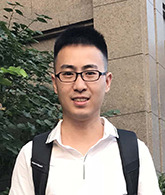 Libo Wu began his Ph.D. studies in the Materials Science and Engineering program
in September 2018 with his own financial support. After the first semester of core
courses in Materials Science, he became interested in Prof. Zhifeng Ren’s research
project on water splitting through electrolysis, with joint advisor Prof. Alamgir
Karim in Materials Science and Engineering. His research training began with
searching for new and improved catalysts for freshwater splitting to generate
hydrogen as an extremely high energy carrier. Water splitting involves two halfreactions,
hydrogen evolution reaction (HER) and oxygen evolution reaction (OER),
with HER always more efficient. For efficient water splitting, efficient catalysts for both HER and OER are
needed. Through hard and persistent work, Libo quickly mastered the experimental skills and techniques on
water splitting and discovered a few outstanding catalysts together with his senior lab peers. As there is much
less freshwater than seawater on earth, he immediately turned his focus to seawater splitting. With the
experience gained in freshwater studies, he explored and found novel catalysts for electrochemical seawater
splitting. He has also been designing efficient catalysts for fuel cells and designing efficient catalysts for
aqueous and flexible zinc air batteries. Libo’s initial efforts have led to seven outstanding papers in Energy &
Environmental Science, ACS Energy Letters, Research, Journal of Materials Chemistry A, Advanced
Functional Materials, Nano Energy, and Applied Catalysis B: Environmental. Of seven publications, he is the
lead author on five.
Libo Wu began his Ph.D. studies in the Materials Science and Engineering program
in September 2018 with his own financial support. After the first semester of core
courses in Materials Science, he became interested in Prof. Zhifeng Ren’s research
project on water splitting through electrolysis, with joint advisor Prof. Alamgir
Karim in Materials Science and Engineering. His research training began with
searching for new and improved catalysts for freshwater splitting to generate
hydrogen as an extremely high energy carrier. Water splitting involves two halfreactions,
hydrogen evolution reaction (HER) and oxygen evolution reaction (OER),
with HER always more efficient. For efficient water splitting, efficient catalysts for both HER and OER are
needed. Through hard and persistent work, Libo quickly mastered the experimental skills and techniques on
water splitting and discovered a few outstanding catalysts together with his senior lab peers. As there is much
less freshwater than seawater on earth, he immediately turned his focus to seawater splitting. With the
experience gained in freshwater studies, he explored and found novel catalysts for electrochemical seawater
splitting. He has also been designing efficient catalysts for fuel cells and designing efficient catalysts for
aqueous and flexible zinc air batteries. Libo’s initial efforts have led to seven outstanding papers in Energy &
Environmental Science, ACS Energy Letters, Research, Journal of Materials Chemistry A, Advanced
Functional Materials, Nano Energy, and Applied Catalysis B: Environmental. Of seven publications, he is the
lead author on five.
About the Texas Center for Superconductivity at the University of Houston (TcSUH)
TcSUH is the largest multidisciplinary university-based superconductivity and advanced materials research center in the U.S., with more than 240 faculty, postdoctoral fellows, graduate, and undergraduate students, and visiting scientists. The Center¹s personnel create and develop high temperature superconducting and advanced materials, further their understanding, and develop commercial applications.
